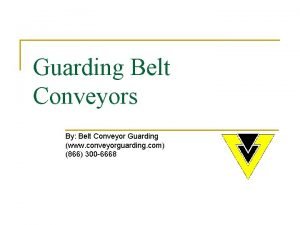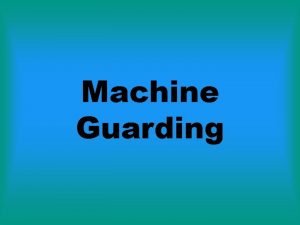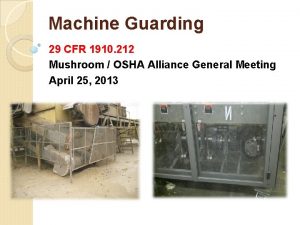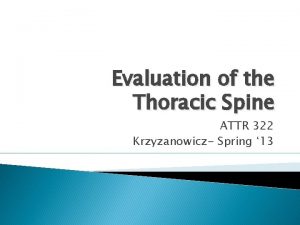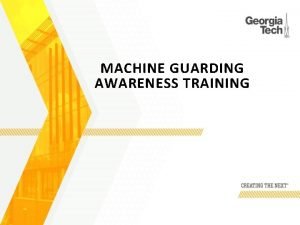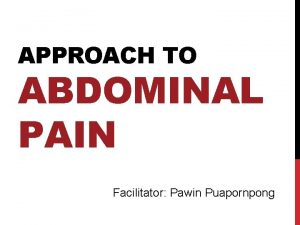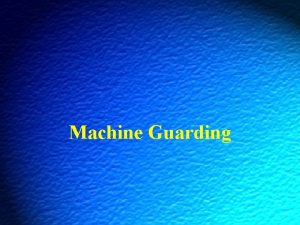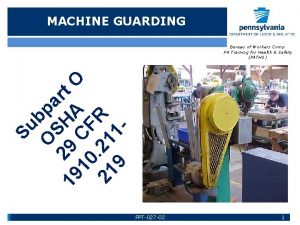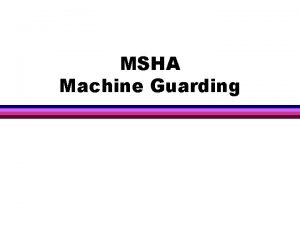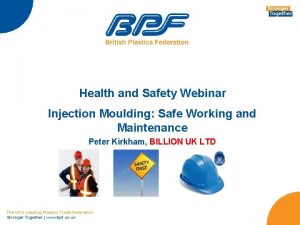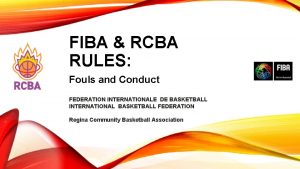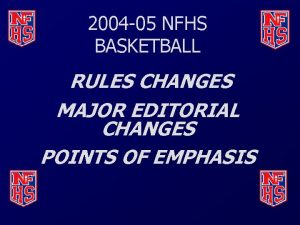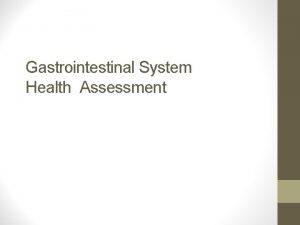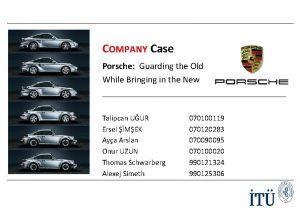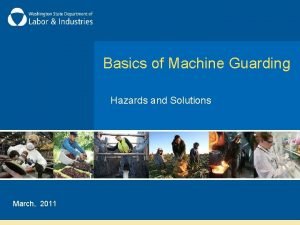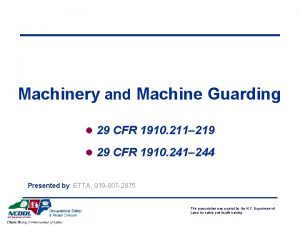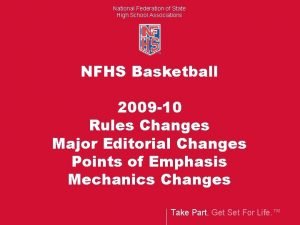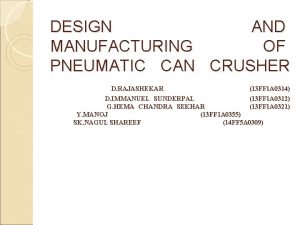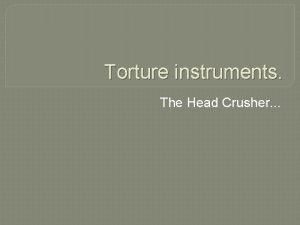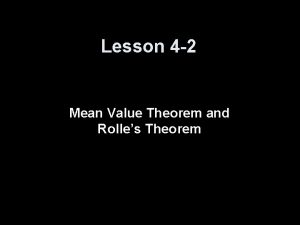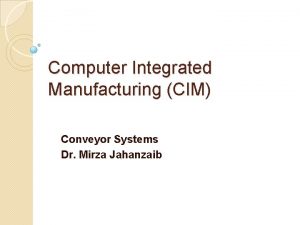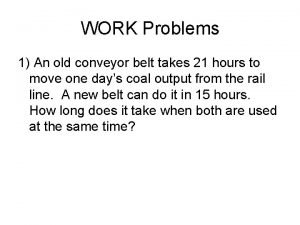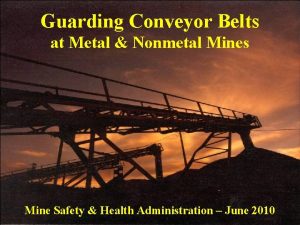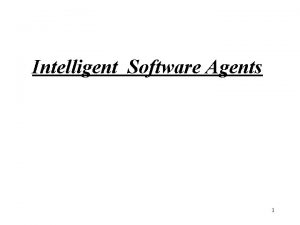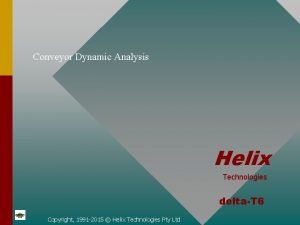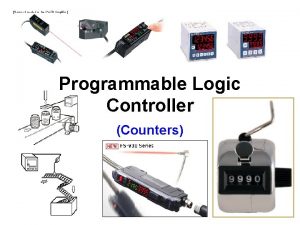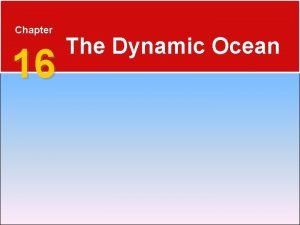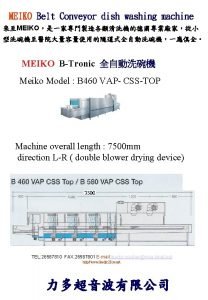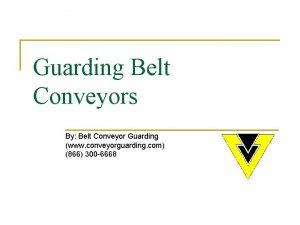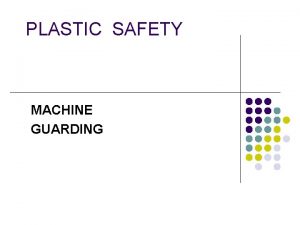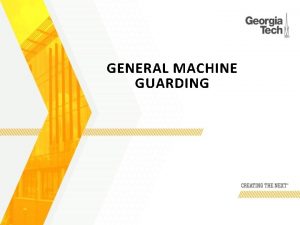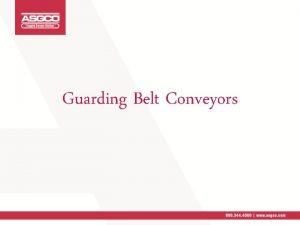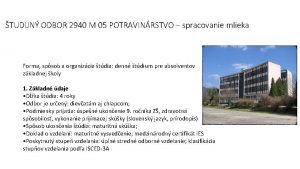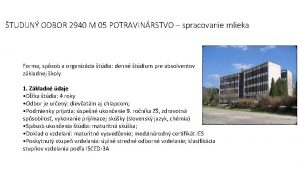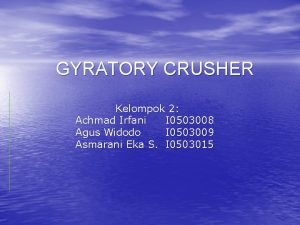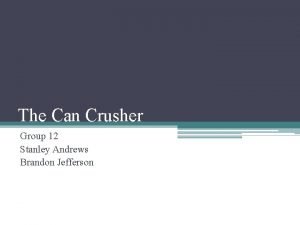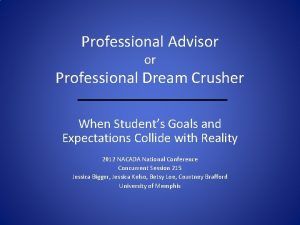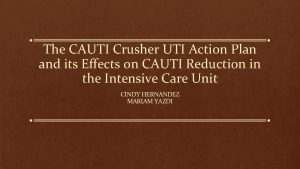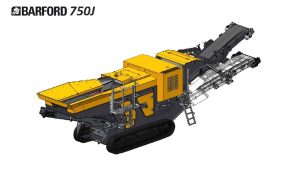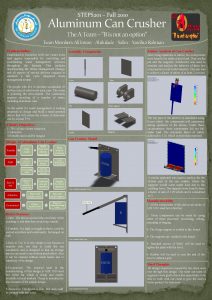CONVEYOR CRUSHER SAFETY 56 14107A Guarding 2940 of

















































- Slides: 49

CONVEYOR & CRUSHER SAFETY

56. 14107(A � Guarding � 2940 of Moving Machine Parts (2007) � 13. 9%

GUARDS


METAL/NONMETAL MINE FATALITY � On May 22, 2008, a 46 year-old equipment operator with 15 weeks experience was fatally injured at a surface crushed stone operation. He had been dumping rock into a portable crusher using an excavator when the feeder portion of the crusher apparently clogged. The victim remotely shut off the feeder but left the crusher and discharge belt running. He climbed onto the feeder to check it and fell into the crusher.


BEST PRACTICES � SLAM Risks (Stop, Look, Analyze, and Manage). Establish and discuss safe work procedures. Identify and control all hazards. Ensure the job is done safely. � De-energize and lock out all components of portable crushers before performing work even if the task is brief. � Guard or shield crushers to protect persons against flying or falling materials. � Train all persons to recognize fall hazards.

METAL/NONMETAL MINE FATALITY � On November 10, 2006, a 41 year-old equipment operator, with 4 years mining experience was fatally injured at a sand gravel operation. � The victim and a co-worker were standing underneath the head pulley section of a conveyor preparing to attach a chain that was to be used to move the conveyor. The bolts connecting the conveyor truss sections in the conveyor's frame failed, causing the head pulley section to fall and strike the victim.


BEST PRACTICES � Stop, Look, Analyze, and Manage (SLAM) each task to identify all potential hazards before performing maintenance work. Practice safe work habits during the entire task. � Train miners in safe work procedures before beginning repairs. � Securely block equipment against all hazardous motion at all times while performing maintenance work

METAL/NONMETAL MINE FATALITY � On May 3, 2006, a 19 -year-old laborer, with 4 weeks mining experience, was fatally injured at a sand gravel operation. � The victim was underneath a feeder conveyor belt and was adjusting it when he became entangled between the belt and the return idler.


BEST PRACTICES � � Ensure that miners are properly task trained in procedures to safely adjust conveyor belts that are in operation. A competent person should closely observe the miner while he performs the task to ensure they are protected from hazardous motion of the conveyor. Before assigning miners to adjust belts, have them identify hazards and demonstrate how they would safely complete the task. Stop, Look, Analyze, Manage ( SLAM ). Keep all guards securely in place except when testing or making adjustments. Install local stop switches at all conveyor locations and ensure start up warning alarms are operational where visual observation of the entire conveyor is not possible from the start up control.

NONMETAL MINE FATALITY On March 18, 1999, a 56 year-old superintendent with 4 weeks mining experience was fatally injured at a sand gravel operation. The victim was using a metal bar to clean mud off of a return roller underneath a conveyor belt when he was caught and drawn into the pinch point.

BEST PRACTICES � Maintenance should not be performed unless the power is off and machinery components are blocked against hazardous motion. � Moving machine parts should be guarded to protect persons from contact that could cause injury. � Mine operators should take measures to ensure all personnel are trained in safe work procedure

56. 14112(B � Guard � 736 Construction (2007) � 3. 28%

METAL/NONMETAL MINE FATALITY � On September 20, 2007, a 49 year-old laborer with 32 years experience (2 days at the mine) was fatally injured at a sand gravel operation. � The victim went behind a guard, used a wooden handle shovel to clean under a conveyor belt take-up pulley, and was entangled in the pulley.


BEST PRACTICES Establish policies to ensure employees are trained to safely remove spillage near moving conveyor belts. � Before assigning miners to clean up spillage, have them identify hazards and demonstrate how they would safely complete the tasks. Stop, Look, Analyze, Manage ( SLAM ) � Deenergize and block conveyor belts against motion before working near the drive, head, tail, and take-up pulleys. �

GUARDS

GUARDS

GUARDS

WALKWAY


ACCIDENTS In a recent five year period, 20 miners died in conveyor-belt accidents. (2004 2008) The leading cause of these accidents was trying to remove material sticking to a roller or pulley while the belt was running

CONSIDER THE FOLLOWING: In these fatal accidents, belt speeds were typically in the range of 300 to 500 feet per minute (fpm). This means the belt was moving from 5 to over 8 feet per second. For the average person, the time needed to react to an unexpected sensation is about one second.

FACTS Putting these facts together shows why working near a running conveyor belt is so dangerous. Even at 300 fpm, in that one second that the average person needs to react, the belt moves over the pulleys and rollers a distance of 5 feet. That's far enough to draw your tool, your loose clothing, gloved or bare hand arm, into a pinch point before you can react.

TAKE THESE TIPS TO WORK WITH YOU: � Don't take chances around a conveyor belt. � Don't perform work that will expose you to a pinch point, like clearing caked material from a roller, while a belt is in operation. � Only work on a conveyor that is locked and tagged out. � If you are working near a stopped belt, and a start-up warning is given, stop what you're doing and get clear!

TIPS � Never cross a moving belt. � Always cross at a bridge or designated crossing point.

CONVEYOR SAFETY � Do not start conveyor until all personnel are clear. � All stopping/starting devices shall be kept free from obstructions, allowing easy access. � Do not ride on, stand on, sit on, walk or run on conveyor at any time.

CONVEYOR SAFETY � Conveyor shall not be loaded beyond its capacity and design limits. � Keep all safety guards on conveyor and in safe repair while running. � Loading and unloading points around conveyor shall be kept clear of obstructions.

CONVEYOR SAFETY � Only trained personnel shall perform maintenance procedures. � Personnel shall be alerted to the potential hazard of entanglement in conveyors caused by items such as long hair, loose clothing, and jewelry.

CONVEYOR SAFETY � Before performing any maintenance procedures, starting devices shall be locked out. � Unsafe practices shall be reported to your supervisor. � Only trained employees shall operate conveyors.

CONVEYOR SAFETY � All personnel shall know location and function of all start/stop controls.

FACTS An average of forty miners are injured each year by material falling from belt conveyors. Although these injuries are generally not serious, almost half result in lost work time. Over a five-year period, the average number of lost-work days per injury was 12 at metal and nonmetal mines and 23 at mines.

SKIRT BOARDS � The use of skirt boards can limit the amount of material that falls from conveyors and exposes miners to injuries. The cost can be optimized by placing the skirt boards at "high-risk" areas along the belt line, where these type of accidents are more likely to occur.

TO REDUCE SUCH ACCIDENTS, MINE OPERATORS SHOULD DO THE FOLLOWING: 1) Install skirt boards on conveyors at locations that have a higher likelihood of material falling off the belt, or a higher chance for miners to be exposed to this hazard, such as: At loading and transfer areas it is recommended that the skirt boards be at least 2 -1/2 times longer than the belt is wide, to allow the material to ‘settle down';

TO REDUCE ACCIDENTS � At areas that have unusual features, such as magnets, crushers, and grizzlies; � At places where persons regularly travel along or cross under the belt; and � At areas where maintenance, clean-up, or inspection activities are frequently performed.

AT YOUR PERIODIC SAFETY MEETINGS, EMPHASIZE THE FOLLOWING: � In the ‘high-risk' areas mentioned above, miners need to be aware of the potential for falling material while doing clean-up, maintenance, or inspection work. � Under certain operating conditions, such as when a belt is not fully loaded, material may be more likely to bounce or fall off a belt.

SAFETY MEETINGS � When traveling along conveyors (even in a vehicle), miners should keep as far away from the conveyor as possible, without exposing themselves to other hazards. � Even small material can cause injury if it falls from a height or from a fast moving belt.

NONMETAL MINE FATALITY On April 4, 2006, a 23 -year-old laborer, with one month mining experience, was fatally injured at a sand gravel operation. The victim had entered the area under the crusher and traveled near the back side of the discharge conveyor tail pulley. His clothing became entangled in the rotating tail pulley.


BEST PRACTICES � Establish policies that ensure employees are trained on required procedures to safely remove spillage near moving conveyor belts. � Before assigning miners to clean up spillage, have them identify hazards and demonstrate how they would safely complete the tasks.

BEST PRACTICES � Stop, Look, Analyze, Manage ( SLAM ) � Ensure that conveyor belts are deenergized and blocked against motion before positioning yourself near the drive, head, tail, and take-up pulleys.

NONMETAL MINE FATALITY On September 28, 2004, a 64 year-old plant operator, with 17 years mining experience, was fatally injured at a sand gravel operation. He was using a water hose to clean spillage under a conveyor. Apparently, a large rock fell from a conveyor located overhead and struck him, resulting in fatal injuries.

BEST PRACTICES Conduct a Risk Assessment evaluating all tasks and identifying potential hazards before performing work. � Never walk under or perform work near moving conveyor belts where there is a danger of being stuck from falling material. � Ensure that guards, shields, or other devices are installed to protect persons from hazards of falling material near conveyors, screens, or crushers. �

NONMETAL MINE FATALITY On January 25, 2005, a 49 -yearold quarry operator, with 14 years mining experience, was fatally injured at a cement operation. The victim was cleaning loose material and pumping water from the primary crusher conveyor belt basement. He contacted an unguarded return idler that was about four feet above the ground and was trapped between the conveyor belt and the return idler.

BEST PRACTICES � Examine work areas to identify all possible hazards and take all precautions to safely perform the task before the work begins. � Ensure that moving machine parts are guarded to protect persons. � Ensure that miners are prohibited from traveling through areas or performing work where they are exposed to moving machine parts that can cause injury.

MAN VS. MACHINE Man lost.
 Conveyor pinch point guards
Conveyor pinch point guards Edg 2940 ucf
Edg 2940 ucf Machine guard types
Machine guard types 1910 machine guarding
1910 machine guarding Solar plexus and sternum
Solar plexus and sternum Machine guarding written program
Machine guarding written program Lodcraft abdominal pain
Lodcraft abdominal pain Osha 1910 machine guarding
Osha 1910 machine guarding Machine guarding ppt
Machine guarding ppt Abd anatomy
Abd anatomy Tail pulley guard
Tail pulley guard Palpation
Palpation Health and safety injection moulding
Health and safety injection moulding Federation
Federation Abdominal guarding
Abdominal guarding Guarding the gospel
Guarding the gospel Troax sweden
Troax sweden Legal guarding position
Legal guarding position Abdominal quadrants
Abdominal quadrants Mirror of guarding reflections
Mirror of guarding reflections Six types of machine guarding
Six types of machine guarding Cfr
Cfr How far is a high school free throw line
How far is a high school free throw line Youtube can crusher
Youtube can crusher Pneumatic can crusher
Pneumatic can crusher Crusher hire harwood
Crusher hire harwood Crocodile scissors torture
Crocodile scissors torture Head crusher medieval
Head crusher medieval Chute conveyor
Chute conveyor Rolles theorem
Rolles theorem Gill plant
Gill plant Stefan immler
Stefan immler What is loop and its types
What is loop and its types Pam jogged up a hill at 6 km/h
Pam jogged up a hill at 6 km/h Return roller guards for conveyors
Return roller guards for conveyors Define software agent
Define software agent Conveyor static analysis
Conveyor static analysis Iocl eprocurement
Iocl eprocurement Counter applications
Counter applications Global conveyor belt
Global conveyor belt Chapter 16 the dynamic ocean
Chapter 16 the dynamic ocean A factory conveyor belt rolls at 3m/s
A factory conveyor belt rolls at 3m/s Dish washing machine
Dish washing machine Conveyor belt cattle feeder
Conveyor belt cattle feeder Ecdis safety settings
Ecdis safety settings Ind safety report
Ind safety report Basic safety orientation
Basic safety orientation Safety care behavioral safety training
Safety care behavioral safety training Construction site safety orientation
Construction site safety orientation Personal safety vs process safety
Personal safety vs process safety
